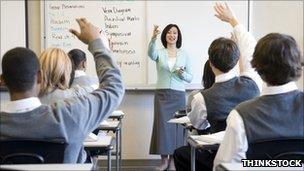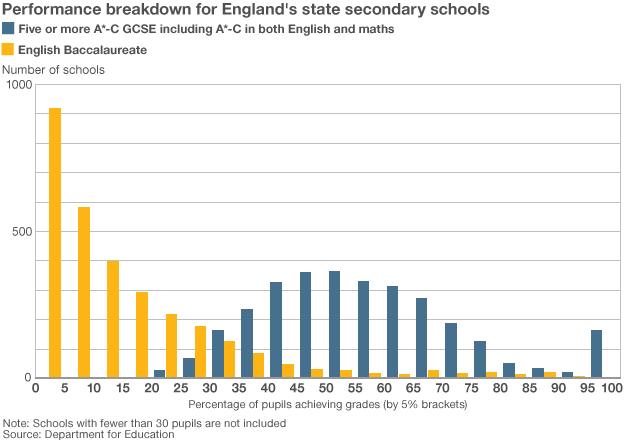School league tables: Most miss Baccalaureate target
- Published

The new league tables are based on last year's exams
Just one in six pupils in England has achieved the new English Baccalaureate introduced by the government, England's league tables show.
The new measure is of how many pupils in a secondary school achieve good GCSE grades in what the government says is a vital core of subjects.
Details have also been released of how much money schools get and how they spend it, showing wide variations.
Education Secretary Michael Gove says he wants parents to "go compare".
Head teachers say the new English Baccalaureate measure is unreliable and that it is unfair to use it now.
They found out just a few weeks ago that it was to feature in the performance tables, external, which are based on last year's GCSE and A-Level results for England's secondary schools and are published by the Department for Education.
Many schools which rank high on the main league table measure have lower scores on that for the English Baccalaureate.
Michael Gove MP: "No-one is served by keeping secret information about what is going on in our schools"
Mr Gove said: "The aim is not to beat anyone up. We want people to learn from the best schools, to shine a light on excellence."
Overall, the academic league tables show most state schools (69%) improved, and fewer failed government targets.
In total, 216 schools did not meet the minimum overall target for GCSEs - meaning tens of thousands of children were taught in under performing schools last year.
A quarter of them are academies - introduced under Labour as the way to turn around failing schools.
That general target - which the government says will stay - is that at least 35% of pupils achieve five "good" passes (A* to C), including maths and English - and pupils make the progress expected from 11 to 16.
Schools below that level - which was raised from 30% by the new government - face being taken over or turned into academies.
If schools this year had been measured on last year's target - 82 would have missed it. Last year, about 300 did so.
The results for the new English Baccalaureate show just 16% of 16-year-olds achieved good grades in the mix of subjects the government thinks they need.
The measure is of how many children achieve good passes in English, maths, a language, geography or history and two science qualifications.
In more than half of state secondaries (1,600), fewer than 10% of pupils achieved this.
And 270 of England's state secondaries scored zero on this measure.
Mr Gove believes that under Labour, many schools pushed children towards less academic qualifications and subjects to boost their league table rankings.
"Labour got its priorities wrong and said kids from poor homes could not do difficult subjects," he said.
Andy Burnham, Labour's education spokesman, said he was worried that the new tables would have "a devastating effect on morale" and "create a new generation of failing schools".
"Labour supports academic rigour, which is why we included English and maths in performance tables and promoted an increase in the take up of separate sciences," he said.
"But we also support student choice which this prescriptive and narrow English Bacc will take away."
'Traditional approach'
The top of the rankings for the new measure is dominated by selective state schools and independent schools.
Bishop Wordsworth's Grammar School in Salisbury is at the top, with 98% of pupils achieving the measure.
Headmaster Stuart Smallwood said the boys' school had always had a "traditional academic curriculum".

The Association of School and College Leaders (ASCL) has complained the English Baccalaureate is a "retrospective indicator".
And it says members are in favour of children having a broad curriculum, including languages, but that some pupils will be more suited to less academic subjects.
Independent school heads have also attacked the measure, describing it as "half-baked" and too prescriptive.
Some of their pupils take qualifications known as iGCSEs - and only some of them have so far been passed for inclusion in the English Bacc.
The Headmasters' and Headmistresses' Conference (HMC) says many top independent schools - including Westminster, Eton, Harrow and Bedales - score zero on the measure.
At the top of the table for pupils getting five good GCSEs including maths and English was Lawrence Sheriff School, a selective boys' school in Rugby.
At the bottom was The Lafford High School in Billinghay, Lincolnshire, where just 8% of pupils reached that goal. The school, which has now closed, is second on the list of those with the highest spend per pupil for last year - £27,000.
Spending divide
Alongside the school performance data on GCSEs and A-levels is a new measure of how schools perform on the basics of English and maths.
And for the first time details have been released nationally of school spending , external in the state sector.
This covers both primary and secondary schools but does not include academies. That is because the information on academies is held by the Charity Commission, the government says.
A database shows spending by school, including the total budget, the amount spent per pupil and a breakdown of what the money is spent on - for example teaching staff, ICT, supply teachers and energy.
The government says it shows no link between spending and attainment and that there are wide variations between similar schools in what they spend in various areas - such as backroom costs.
Mr Gove said: "We are empowering parents and the public to 'go compare'. If you can discover that the school down the road is doing twice as well while spending half the cash you will ask 'Why?'"
The data shows the amount spent per pupil in 2009-10 varies greatly in secondary schools - from as little as £1,500 to nearly £33,000 - though most schools fall in the £4,000 to £9,000 range.
Nationally, the median spend per pupil at secondary level was £5,212.
In a complex funding formula, schools received extra funding if they were in areas of deprivation and to support various programmes.
The median spend for those with the highest proportion of pupils on free schools meals was £7,550.
And for those in the lowest deprivation band it was £5,394.
In primaries, the national median spend per pupil was £4,037.
Mr Gove says the information may help schools make the most of their resources.
- Published8 January 2011
- Published24 November 2010
- Published11 January 2011
- Published24 August 2010
- Published9 September 2010